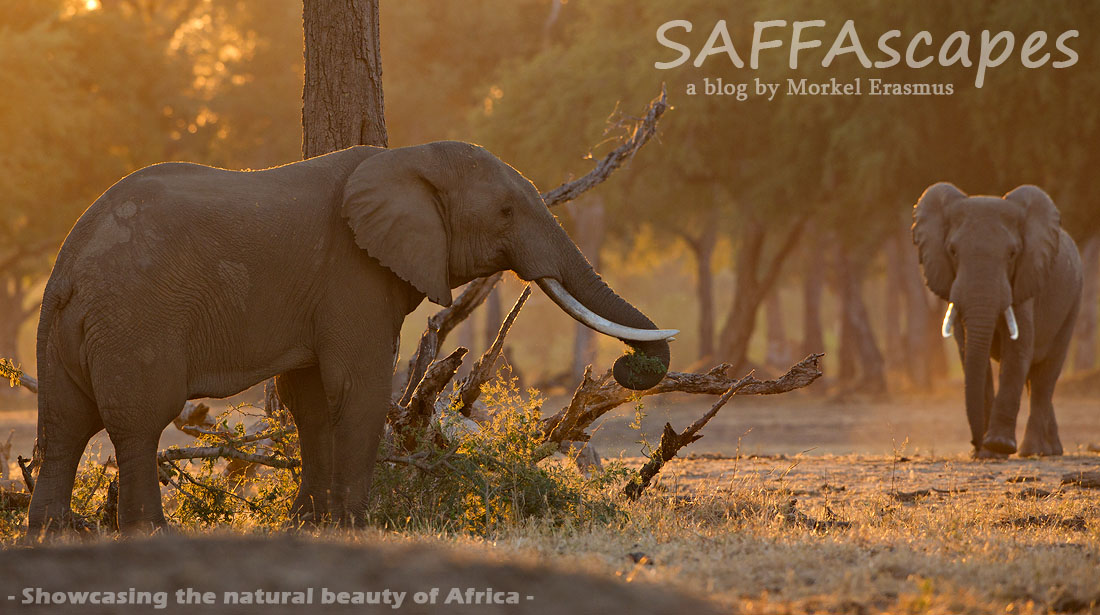If you have been following my photography for more than a month you would have noticed that I often share these kinds of images.
I like to call it "The Animalscape".
The animal in the landscape.
The landscape with the animal(s) in it.
 |
| "Giraffe Sunrise" - Etosha, Namibia Nikon D3s | Nikkor 70-200mm f2.8 VR-II @ 70mm | f5.6 | 1/320 SS | ISO-200 |
I guess I like it so much on the one hand because it brings together my two preferred photographic genres: wildlife photography and landscape photography.
On the other hand, and I think this is the main reason I like it: I think this kind of image paints a better context and story about the wilderness areas of Africa that are so quickly dwindling.
We cannot preserve the wildlife if we don't preserve the habitat.
And yet it is futile to preserve the habitat while killing off the wildlife.
The two are interconnected, intertwined, inseparable...
 |
| "Shake it!" - Mara Triangle, Kenya Nikon D800 | Nikkor 70-200mm f2.8 VR-II @ 70mm | f5.6 | 1/1600 SS | ISO-1000 |
This kind of image is all about telling the bigger story of the the species you are photographing. Where do they roam? Where do they eke out their survival? What other species live around them? What's the weather like?
The biggest mistake you can make is to think the only way you can create an animalscape is to use a wide angle lens. Sure, wider angles work well to show as much of the environment as possible, but you either need a very big subject (think elephant or giraffe) or you need to be super close to the subject. I often use the Nikkor 24-70mm f2.8 lens for these shots. You can't go too wide in most cases for fear of losing the subject in the frame.
An example of a wide angle animalscape:
 |
| "Cotton Candy Clouds" - Chobe National Park, Botswana Nikon D800 | Nikkor 24-70mm f2.8 @ 31mm | f5.6 | 1/400 SS | ISO-180 |
The wide angle emphasizes the extreme depth of the scene, the immense sky, and the elements of the landscape. The elephant is just big enough to be a key element in the composition.
The mid-range zoom lens can often be used for effective animalscapes. For this purpose my go-to lens is the Nikkor 70-200mm f2.8 VR-II, as it's tack sharp through the focal range, and super quick to focus.
 |
| "Long Line of Leavers" - Mara Triangle, Kenya Nikon D800 | Nikkor 70-200mm f2.8 VR-II @ 135mm | f9.0 | 1/640 SS | ISO-220 |
It doesn't have to stop there, though. I find it amusing that so many wildlife photographers only feel they are using their super telephoto lenses properly if they can use it to fill the frame with a portrait of the animal's face or full body. If a subject is deemed "too far" the possibility of a workable shot being taken is not even considered. The telephoto compression effect can bring a different element to the animalscape. My previous telephoto was the Nikkor 500mm f4 VR-II, which I traded last year for the Nikkor 400mm f2.8 VR-II. You obviously won't include as much of the landscape, but that's not the point.
 |
| "Cheetah on the Plains" - Mara Triangle, Kenya Nikon D3s | Nikkor 500mm f4 VR-II | f8.0 | 1/800 SS | ISO-900 |
When it comes to producing compelling photos of this nature, I cannot stress enough how important a sense for good composition is to the photographer. You need to be able to include enough AND exclude enough of the surrounding scene to tell the story and "paint" the tapestry as simplistic yet engaging as possible. Study other photographers' work. Study the works of famous painters. Know what the language of composition entails - it's a language that's often not put into words, but comes across as a philosophical aesthetic.
I hope this post encourages you to try your hand at more of these kinds of photos.
I wish more wildlife photographers would venture for the contextual shot, the animalscape, to show people not just the wonderful wildlife they encounter, but also the amazing landscape in which those animals carve out an existence.
Keep clicking!
Morkel Erasmus
















